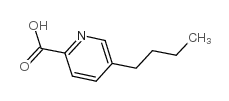Impact of biological control agents on fusaric acid secreted from Fusarium oxysporum f. sp. gladioli (Massey) Snyder and Hansen in Gladiolus grandiflorus corms.
Walid Nosir, Jim McDonald, Steve Woodward
Index: J. Ind. Microbiol. Biotechnol. 38(1) , 21-7, (2011)
Full Text: HTML
Abstract
Fusaric acid (FA) (5-n-butylpuridine 2-carboxyl acid), a highly toxic secondary metabolite produced by Fusarium oxysporum strains, plays a significant role in disease development. The abilities of three F. oxysporum f. sp. gladioli (Massey) Snyder and Hansen isolates (G010; 649-91; and 160-57) to produce FA in infected Gladiolus corm tissues was evaluated in vitro in relation to the presence of two biological control agents, Trichoderma harzianum T22, and Aneurinobacillus migulanus. Pathogenicity tests were used to differentiate between the abilities of the F. oxysporum strains to secrete FA. FA was identified using LC/MS and quantified using HPLC. Isolate G010 was significantly more virulent (P < 0.01) on Gladiolus grandiflorus corms; it secretes 1.8 μM FA/g fresh weight corm into inoculated Gladiolus. Moreover, G010 was the only isolate that produced FA among the three examined isolates. There was a correlation between the corm lesion area and the FA secretion ability of F. oxysporum f. sp. gladioli (P < 0.001; r (2) = 0.96). No FA was detected in PDA cultures of F.oxysporum f. sp. gladioli isolates. The presence of T. harzianum T22 appeared to prevent FA secretion into the corms. In the presence of A. migulanus, however, the amount of FA secreted into the corm tissues increased. These results support the use of T. harzianum as an effective biological control agent against F. oxysporum f. sp. gladioli.
Related Compounds
| Structure | Name/CAS No. | Molecular Formula | Articles |
|---|---|---|---|
 |
Fusaric acid
CAS:536-69-6 |
C10H13NO2 |
|
Characterization of TolC efflux pump proteins from Pasteurel...
2008-11-01 [Antimicrob. Agents Chemother. 52 , 4166-71, (2008)] |
|
Chemical genetics reveals a complex functional ground state ...
2007-05-01 [Nat. Chem. Biol. 3(5) , 268-273, (2007)] |
|
Identifying chelators for metalloprotein inhibitors using a ...
2011-01-27 [J. Med. Chem. 54 , 591-602, (2011)] |
|
Determination of the Mycotoxin Content in Distiller's Dried ...
2015-11-04 [J. Agric. Food Chem. 63 , 9441-51, (2015)] |
|
Fusaric acid induces a notochord malformation in zebrafish v...
2015-08-01 [Biometals 28 , 783-9, (2015)] |